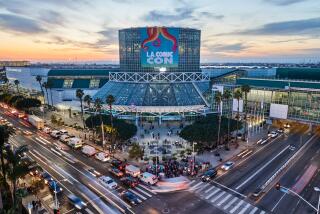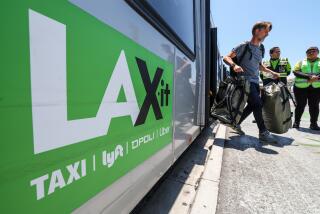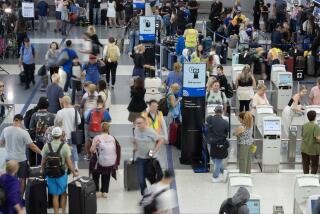FAAâs History Travels From Wheelbarrows to Computers
It started back in the 1920s with a guy who had a shed, a wheelbarrow and some flags.
He would push the wheelbarrow with the flags out of the shed and down to the end of the airstrip at Midway Field in Chicago. If he could see a plane up there and everything looked all right, he would take out the appropriate flags and wave them to tell the pilot to land.
The outfit he worked for was called the Aeronautics Branch, part of the Department of Commerce. Later it became the Bureau of Air Commerce, then the Civil Aeronautics Authority, then the Civil Aeronautics Administration and finally, in 1958, the Federal Aviation Administration, better known as the FAA.
Things got a little fancier along the way.
Today, the guy with the wheelbarrow has been replaced by a staff of more than 12,500 air traffic controllers, graduates of the FAAâs academy at Oklahoma City.
The shed has been replaced by a network of facilities that includes a flow control headquarters in Washington, 20 regional control centers blanketing the nation and scores of approach control and tower control complexes at individual airports from coast to coast.
The wheelbarrows and flags have been replaced by more than 23,000 pieces of electronic equipment--radar systems, computers and radio gear designed to help the FAA keep track of--and keep in touch with--the aircraft under its control.
One Specific Task
All these people, places and things have been assembled to perform one specific task--the âsafe, orderly, expeditious movement of air trafficâ across the country, with the priorities in that order.
Among the aircraft FAA controllers monitor and advise are thousands of planes--commercial, private and military aircraft--that pass each day through the skies over Southern California--some of the most congested airspace in the world.
Most pilots file instrument flight plans before takeoff. These plans, which include the aircraftâs identification code, departure point and time, cruising altitude and speed, estimated time en route and destination point, are entered into the âmonster,â a master computer at the FAAâs Central Flow Control Facility in Washington. About a dozen men work in the brightly lighted command center above Independence Avenue, perusing a clutter of high-speed printers and color television monitors.
The printers and monitors offer up information that includes flight plans, weather data and updated reports on holiday crowds, sporting events, airfield construction and other factors that could contribute to air traffic congestion. This information is used to orchestrate the flow of planes in and out of the 22 âpacing airportsâ--among them Los Angeles International--that account for about a quarter of the passenger traffic in the United States.
âThe Monster Knowsâ
âThe monster knows where every plane is and where itâs going,â said Sam Rosenzweig, an operations officer at the command center. âIf things begin to build up, the computer calculates the delays needed to sequence the individual flights into the individual airports.â
If necessary, flights are held at the departure gate until they can be merged smoothly into the national traffic pattern. Airborne planes are sometimes slowed, but the command center seldom resorts to the fuel-consuming âholding patternsâ of decades past, when airliners were made to circle before they could land.
As aircraft under FAA control proceed across the nation, they pass through a series of âadvisory areas.â There are 20 of these, each of which is monitored by one of the FAAâs regional control centers.
The Los Angeles Air Route Traffic Control Center at Palmdale--commonly called the Los Angeles Center--controls as many as 300 aircraft at a time in an oblong 180,000-square-mile swatch of airspace covering southwest Utah, southern Nevada, western Arizona, Southern California and a stretch of the Pacific reaching about 200 miles out to sea.
The centerâs advisory area is divided into 33 sectors. Some of the sectors overlap, with low sectors covering airspace below 23,000 feet and high sectors covering airspace above that. There are several islands of airspace within the advisory area--zones surrounding major airports--that are controlled by terminal radar approach control (TRACON) centers, known to pilots as approaches. Some airspace within the TRACONs is controlled by airport towers.
Ten radar installations provide overlapping coverage of the advisory areaâs rugged terrain. A computer at Palmdale determines which radars are providing the best coverage of a given piece of sky and uses a process known as mosaicking to form composite images on the controllersâ screens.
On a day when traffic is heavy, as many as 120 controllers, assistants, supervisors and technicians hunch over the three long rows of radar display screens--51 in all--that run lengthwise down the 200-foot room.
The lighting, and the voices, are subdued. Like the headquarters of a major international bank, the place is busy, but an aura of calm prevails. Unlike bank employees, everybody is wearing Leviâs and tennis shoes.
Each of the advisory areaâs 33 sectors is assigned one of the radar display screens in the control room. Depending on the traffic load, each sector screen may be worked by as many as three people--a radar controller, a manual controller and an assistant.
The radar controller observes the planes on the screen, giving instructions or relaying information via radio to the dozen or so aircraft that may be under his control at one time. The manual controller coordinates the handoff of aircraft into and out of his sector, using the telephone to reach controllers in other sectors or neighboring advisory areas. The assistant updates and disseminates paper printouts of each planeâs flight plan that follow the aircraft as it moves from sector to sector through the control room.
Bewildering Display
The image on each circular 22-inch radar display screen is bewildering to the neophyte. There is a spattering of crosses, dots, slashes, Vâs and groupings of numbers and letters--all of which jerk slowly across the screen and all of which represent airplanes. These symbols are scattered about on a fixed field of seemingly stray lines, only a few of which represent recognizable topographical features like shorelines.
To an experienced controller, it makes sense, providing a picture--updated with every 12-second sweep of the radar antennas--of planes passing through his sector.
The crosses and dots show primary returns--simple radar echoes from each of as many as 100 or more planes that may appear at a given time in a single sector. Most of these returns represent planes that are not under FAA control--small, private aircraft flying outside the terminal control areas and high altitude air routes largely reserved for commercial traffic. Pilots of planes not under FAA control must rely solely on their vision to keep clear of other aircraft.
The slashes usually represent airplanes under FAA control--planes equipped with transponders that are capable of broadcasting additional information about the aircraft. The groupings of numbers and letters are data blocks containing this information--things like a planeâs identification code, altitude and speed. Controllers use their radios to help the pilots of such planes maintain safe separation from other aircraft.
The Vâs represent planes with transponders that are not under FAA control. Like the planes represented by dots and crosses, they are on their own.
The fixed lines show things like airports, major air routes and a few topographical features to help controllers pinpoint the location of each aircraft.
Windowless Room
As a plane under FAA control nears the airport at which it is to land, control switches from the regional center to the TRACON center handling approaches to the runways at that airfield.
Los Angeles TRACON, which handles the approaches to the four parallel east-west runways at Los Angeles International Airport, is a windowless room in a dreary hangar on Imperial Boulevard, on the south side of the field.
Far smaller than the control room in Palmdale, it is also much darker. The 15 or so people usually found working there use old-fashioned radar systems with display screens that can only be read with the lights out. The flickering, four-second sweeps on the screens lend a dramatic air, but as at the center at Palmdale, there is no commotion--itâs all business.
Once a plane has been lined up with a runway at Los Angeles International, control switches again, to the cab atop the airportâs 150-foot tower.
Compared to windowless control centers at L.A. TRACON and Palmdale, the rectangular tower control cab at LAX is a bright, airy place, with big plate-glass windows overlooking the hubbub of the airport on all four sides. Once again, it is mostly business, but the conversation is a little livelier here, with banter filling the relaxed moments between planes.
Few Use Radar
Two local controllers monitoring takeoffs and landings usually work in the tower. They are joined by two manual controllers responsible for handoffs to and from L.A. TRACON, two ground controllers coordinating the movement of planes along the miles of airport taxiway and a controller whose sole job is to handle takeoffs and landings of helicopters.
Except for the ground controllers, who use a small radar mounted atop the tower to observe the planes on taxiways, tower personnel watch most of the traffic through the windows. The radar displays used by L.A. TRACON are available through a television hookup, but tower controllers seldom rely heavily on them when visibility is good. If a plane is lined up properly and there are no observable hazards in the air or on the ground, it is given clearance to land.
More to Read
Sign up for Essential California
The most important California stories and recommendations in your inbox every morning.
You may occasionally receive promotional content from the Los Angeles Times.










